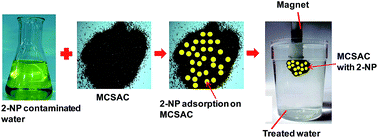Sustainable development of coconut shell activated carbon (CSAC) & a magnetic coconut shell activated carbon (MCSAC) for phenol (2-nitrophenol) removal†
Abstract
Slow pyrolysis coconut shell (CSAC) and magnetic coconut shell (MCSAC) activated carbons were prepared, characterized and used for aqueous 2-nitrophenol (2-NP) removal. Magnetization was carried out using a co-precipitation method. The chemical composition, surface properties and morphology were examined using proximate and ultimate analyses. The carbons were microporous with a BET surface area of 607 m2 g−1 (CSAC) and 407 m2 g−1 (MCSAC). Both batch and column studies were conducted. The carbons efficiently remediated 2-nitrophenol (2-NP) contaminated water at pH 4.0. Sorption equilibrium studies were conducted at 25, 35, and 45 °C. Experimental data were fitted to Langmuir, Freundlich, Sips, Temkin, Redlich–Peterson, Radke and Prausnitz, Toth, and Koble–Corrigan equations. Sips and Koble–Corrigan equations best fitted the 2-NP adsorption data. A pseudo-second-order model best described the kinetics data. Columbic interactions, hydrogen bond formations, π–π donor–acceptor interactions, and dipole–dipole interactions were the possible mechanisms for 2-NP removal. MCSAC was easily recovered from an aqueous system using an external magnet and successfully regenerated using methanol. Fixed-bed studies were conducted at room temperature with an initial 2-NP concentration of ∼13 mg L−1, 2.0 g CSAC, pH 4.0 and a flow rate of 4 mL min−1. A column capacity of 102.8 mg g−1 was obtained. 2-NP desorption was also carried out under the same flow rate, and bed height using ten successive aliquots each containing 20 mL of methanol. The first aliquot of 20 mL of methanol desorbed 48% of the total 2-NP recovered and the rest in the further nine increments. These studies clearly demonstrated that developed carbons can serve as potential sorbents for phenol removal to substitute expensive commercial activated carbons.



 Please wait while we load your content...
Please wait while we load your content...